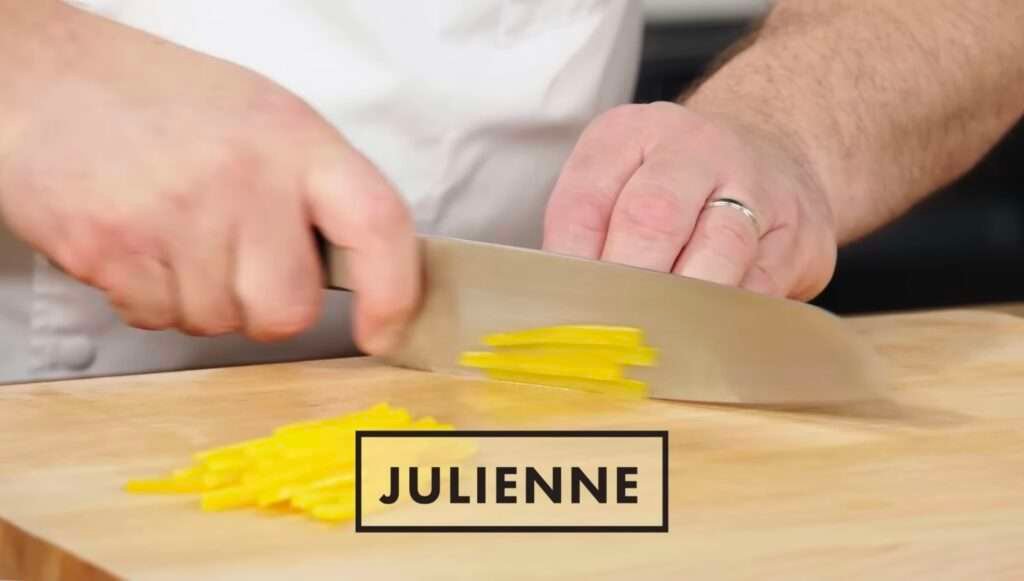Knife skills are the fundamental step to becoming proficient in the kitchen. Knowing how to cut ingredients not only enhances the presentation of your dishes but also helps to enhance the flavors. Here are nine essential cutting techniques every beginner should learn, along with their respective culinary terms.
Holding Terms
1. Secure Your Cutting Board
First things first: Before you even start chopping, ensure that your cutting board is secure. A wobbly cutting board can result in your knife slipping and causing injuries, so an easy fix is to place a damp paper towel underneath it. Alternatively, you can use a non-slip mat or opt for a cutting board with grips.
2. How to Hold Knife

Keep your hand relaxed and hold the knife firmly, but not too tightly. Find a comfortable position to hold the knife. Placing your finger on top of the knife, holding too far back on the handle, or using a dainty grip are all incorrect methods. Instead, place your finger and thumb at the very back of the knife and wrap your finger around it. This way, you’ll have a firm grip and maintain control while chopping.
3. Claw

One common mistake when chopping is to have all your fingers laid flat. Protect your precious fingertips by adopting the claw technique. Curl your non-knife hand into a claw shape, with your fingertips tucked safely away from the blade. This position allows for precise control over the ingredients while minimizing the risk of accidents. Keep the fingertips of your guiding hand tucked under and use your knuckles as a guide for the blade.
4. Slicing Motion

Another common mistake is using a slicing motion. If you chop too aggressively, you won’t achieve a nice, even cut. Instead, opt for a rocking motion when you cut, moving the knife back and forth.
Cutting Terms
5. Dice

So far an onion which is probably the common thing you’re going to dice.
a. First, cut an onion in half through the root.

b. Peel off the outer layer of the onion, ensuring that the root end remains intact.

c. Make sure the flat side is facing down for stability. Using the claw grip, make a few horizontal incisions into the onion.

d. Then, turn the onion towards you with the root side furthest away, and again using the claw grip, make a few vertical cuts.

e. Turn the onion again and use your knuckles as a guide. Proceed to chop along in the same smooth, waving motion.


6. Mincing

The most common of these is minced garlic
a. First, remove the root end, and remember, we’re always using that claw grip.
b. Place the garlic under the blade and smash down.

c. Peel the garlic; the papery skin should fall right off. Then, again using the claw grip, employ that same waving motion. Repeat this process numerous times.

Mincing finer yields more flavorful dishes. Anything larger than this would be considered a fine chop. Like dicing, mincing is a very common technique that can be used in numerous preparations.
7. Chiffonade

This fancy cut most commonly used with herbs. It’s mainly used for garnishes. That is very thin shred or a very thin thread of herbs. We’re going to demonstrate with some basil.
a. Take some basil and stack them up nice and flat.

b. Roll these basil into a nice bundle. The important thing is to slice through without bruising the herb, so having a sharp knife is important.

c. Make a high, straight cut through. If you simply chop down on it, you’ll bruise the basil, causing it to turn black.


8. Julienne

This is a fine matchstick cut. It’s pretty and serves as a garnish. It’s another precision cut used to make food look good.
a. So, for a julienne cut, take a pepper.
b. Remove both ends of the pepper and cut out the center part.

c. Cut into small pieces that are easily manageable.

d. Press down lightly on your knife and saw away the excess pepper. You will have a nice, thin slab.

e. Again, using your claw grip, hold the pepper and push the knife straight down. Do not rock, just push through to create nice matchsticks


If you just kind of push down you’re kind of crunching into it and crushing the pepper, not getting a nice even cut.

9. Slice

We’re looking for is a very thin even layer something you might put on a hamburger or on a sandwich. Tomatoes are round, bit they are easily gripped.
a. Take a tomato and hold it nice and tight.
b. When you cut, use a little bit of a slicing or sawing motion.

c. You will get nice, even, thin slices.

If you want to work with an onion:
a. Take an onion.
b. Cut off both ends of the onion.

c. Peel off the skin.
d. Cut it in half.

e. Cut across the lines of the onion. It’s more of a sawing motion than a chopping motion.


This will give you nice half-moon slices instead of irregular cuts to add to your salad or sandwich.

